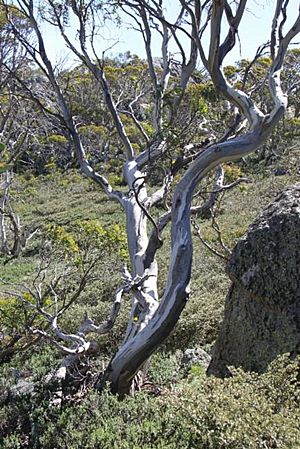Eucalyptus pauciflora subsp. niphophila facts for kids
Quick facts for kids Snow gum |
|
|---|---|
 |
|
| Subspecies niphophila near the summit of Mount Kosciuszko | |
| Scientific classification |
|
| Kingdom: | Plantae |
| Clade: | Tracheophytes |
| Clade: | Angiosperms |
| Clade: | Eudicots |
| Clade: | Rosids |
| Order: | Myrtales |
| Family: | Myrtaceae |
| Genus: | Eucalyptus |
| Species: | |
| Subspecies: |
E. p. subsp. niphophila
|
| Trinomial name | |
| Eucalyptus pauciflora subsp. niphophila (Maiden & Blakely) L.A.S.Johnson & Blaxell
|
|
The Eucalyptus pauciflora subsp. niphophila, commonly known as the snow gum, is a special type of tree or large bush. It grows naturally on some mountain peaks in eastern Australia. This plant has smooth bark and shiny green leaves. Its flowers are white, and its fruit looks like a small cup. The snow gum is different from other types of E. pauciflora because its flower buds have delicate stalks and its leaves are smaller.
Contents
What Does the Snow Gum Look Like?
The snow gum is a tree or shrub that usually grows up to 7 m (23 ft) tall. It has a special woody swelling at its base called a lignotuber. This helps the plant regrow after fires.
Its bark is smooth and can be grey, white, or cream-coloured. It often has patches of yellow and pink. The younger branches have a waxy, bluish-white coating, which scientists call glaucous.
Leaves
Young snow gum plants and new shoots have dull bluish-green leaves. These leaves are egg-shaped, about 25–75 mm (0.98–2.95 in) long and 20–35 mm (0.79–1.38 in) wide. They have a stalk, or petiole.
Adult leaves are shaped like a spear, an egg, or an oval. They are 50–100 mm (2.0–3.9 in) long and 12–30 mm (0.47–1.18 in) wide. Their stalks are about 10–20 mm (0.39–0.79 in) long.
Flowers and Fruit
The snow gum's flower buds grow in groups of nine to fifteen. They are found where the leaves meet the stem, called the axil. These buds grow on a stalk (called a peduncle) that is about 5–10 mm (0.20–0.39 in) long. Each individual bud also has its own small stalk, up to 4 mm (0.16 in) long.
When the buds are ready, they are oval or club-shaped. They measure about 4–8 mm (0.16–0.31 in) long and 3–6 mm (0.12–0.24 in) wide. Each bud has a rounded or beaked cap, known as an operculum.
Snow gum flowers are white. They have been seen blooming between December and February. After flowering, the plant produces a woody fruit. This fruit is a capsule that looks like a cup, cone, or half-sphere. It is about 6–10 mm (0.24–0.39 in) long and wide. The parts that open to release seeds (called valves) are usually near the rim or just below it.
This specific type of snow gum (subspecies niphophila) is different from others. It has more delicate flower buds with stalks, smaller leaves, and its branches, buds, and fruit all have that special bluish-white coating.
How the Snow Gum Got Its Name
The snow gum was first officially described in 1929 by two botanists, Joseph Maiden and William Blakely. They wrote about it in Maiden's book, A Critical Revision of the Genus Eucalyptus. They found the plant near "Pretty Point" on Mount Kosciuszko.
Later, in 1973, two other scientists, Lawrie Johnson and Donald Blaxell, decided that this plant was actually a subspecies of E. pauciflora. So, they renamed it E. pauciflora subsp. niphophila.
The second part of its scientific name, niphophila, comes from ancient Greek words. It means "snow-loving." This name perfectly describes where this eucalypt lives—in cold, snowy mountain areas!
Where the Snow Gum Grows
This snow gum subspecies lives on the highest mountains in the Snowy Mountains where trees can still grow. You can find it in places like the Kosciuszko National Park. It also extends to Bimberi Peak in the Australian Capital Territory. In Victoria, it grows on high peaks such as Mount Hotham, Mount Bogong, Mount Torbreck, and Mount Wellington.

